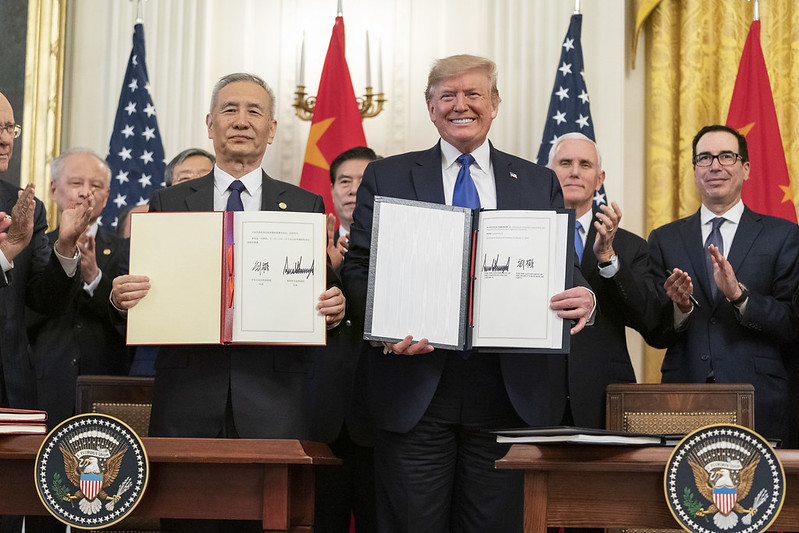Phase 1 with China Failed. It’s Time for Phase 2.
Share

The deal cut by President Trump has come to a close, and we need to think about what a successful China trade strategy should look like.
Two years ago the Trump administration announced it had reached a “very large” and “historic” trade deal with the Chinese government. Sort of.
It was less of a deal and more of a détente, after 18 months of competing tariff rate increases on hundreds of billions of dollars of goods and belligerent statements between the White House and Beijing. President Trump seemed determined to prove that unilateral pressure would compel the Chinese government to make significant and lasting changes to its economic management practices and predatory trade policies.
Trump, of course, didn’t get those changes made, and instead cut a very transactional deal in an attempt to show progress on an important political goal during a re-election year. The agreement was branded as Phase One of continuing negotiations, implying they’d come back to the important stuff later.
But Trump has since lost re-election and returned to his home in Florida, and we’ve reached the end of the détente. China has fallen short of its Phase One purchasing commitments by, as the Wall Street Journal put it, a “wide margin.” And it’s President Biden’s problem now.
Should Biden hold China accountable for breaking the deal, which would mean the re-imposition of tariffs and likely Chinese retaliation while the American economy is fragile? Should he let China off the hook, which was the modern norm before his belligerent predecessor took office in 2016? Or should he buckle down, assemble likeminded trading partners, and return to the negotiating table to discuss the raft of important issues on which little progress was made?
President Trump always misrepresented trade negotiations as a cakewalk, while no one should have been under the assumption that this was going to be easy. But the third option – buckling down – is the only choice. Ignoring these problems will further erode U.S. industrial capabilities just as most Americans are coming to understand how woefully unprepared we really are.
The main takeaway from the January 2020 agreement was that China would purchase approximately $74 billion of agricultural goods, $211 billion of manufactured products and $68 billion of energy products from the United States. The latest figures show it’s roughly $12.5 billion, $86.5 billion and $42 billion short of those obligations. Meanwhile, the 2021 U.S. goods trade deficit with China – a decent barometer for the health of the domestic manufacturing sector that has proven so important in this age of strained global supply chains and scarce reserves of critical products – will be a whopping $350 billion or so when the numbers are made official in a few weeks.
That’s not the highest it’s ever been – it reached a high of $418 billion in 2018 – but it’s in spite of a pandemic-induced recession and tariffs remaining on a significant amount of Chinese imports, and it speaks to the serious dependence the American economy still has on Chinese inputs.
And that’s not all it suggests. The Economic Policy Institute estimates Chinese import competition drained 3.7 million jobs from the American economy between 2001 and 2018, and these sustained deficits hint at the kind of economic activity we’ve outsourced now for decades.
It should be clear to even the most wild-eyed optimists that the Chinese government has no serious intent to reform its economy and unwind state ownership. The opposite seems to be true. Industrial subsidies, chronic and intentional overcapacity, the participation of state-owned enterprises, predatory investment, currency manipulation and misalignment, state-sponsored cyber theft, denigration of labor rights, lax environmental rules, and discriminatory tax policies remain well entrenched.
Should we expect President Biden to do something that no other president has managed to achieve on China? I think not. But it should still be held to account.
And there are hopeful signals of a shift in strategy: investments in our own industrial capabilities, enlisting allies in our efforts, and a continuation of an aggressive trade enforcement posture. Made in America infrastructure, clean energy, and advanced technology investments are promising starts to our industrial policy if they can be sustained. Europe, along with our Asian and North American allies must join us in adopting bolder policies to confront China’s economic aggression. And the administration must be willing to deploy new tools in this competition. Last month the president signed a bill that bans most imports from China’s Xinjiang region, where the state is assimilating its minority Muslim population via what can be plausibly called a cultural genocide and is using forced labor to do it. That must be a first step, not a last word.
The détente is ending, and the status quo of a persistent goods trade deficit simply isn’t tenable. The economic health of the United States demands there must be a strategic uncoupling of critical supply chains and bolder measures to block unfair trade practices. Phase Two of a U.S.-China trade deal must be transformational rather than transactional.
Scott Paul is president of the Alliance for American Manufacturing.
